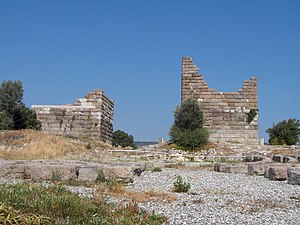Siege of Halicarnassus
| Siege of Halicarnassus | |||||||||
|---|---|---|---|---|---|---|---|---|---|
| Part of the Wars of Alexander the Great | |||||||||
 Ruins of the fortications around Halicarnassus, 4th c. BC | |||||||||
| |||||||||
| Belligerents | |||||||||
| Macedonian Empire | Achaemenid Empire | ||||||||
| Commanders and leaders | |||||||||
| Alexander the Great |
Orontobates, Memnon of Rhodes | ||||||||
The Siege of Halicarnassus was fought between Alexander the Great and the Achaemenid Persian Empire in 334 BC. Alexander, who had no navy, was constantly being threatened by the Persian navy. It continuously attempted to provoke an engagement with Alexander, who would have none of it. Eventually, the Persian fleet sailed to Halicarnassus, in order to establish a new defense. Ada of Caria, the former queen of Halicarnassus, had been driven from her throne by her younger brother Pixodarus of Caria. When Pixodarrus died, Darius had appointed Orontobates satrap of Caria, which included Halicarnassus in its jurisdiction. On the approach of Alexander in 334 BC, Ada, who was in possession of the fortress of Alinda, surrendered the fortress to him. Alexander and Ada appear to have formed an emotional connection. He called her "mother", finding her more amicable than his megalomaniacal snake-worshiping mother Olympias. In return for his support, Ada gave Alexander gifts, and even sent him some of the best cooks in Asia Minor, realizing that Alexander had a sweet tooth. In the past, Alexander had referred to his biological father, Philip, as his "so-called" father, and preferred to think of the deity Amon Zeus as his actual father. Thus, he had finally managed to divorce himself from both of his biological parents.
Orontobates and Memnon of Rhodes entrenched themselves in Halicarnassus. Alexander had sent spies to meet with dissidents inside the city, who had promised to open the gates and allow Alexander to enter. When his spies arrived, however, the dissidents were nowhere to be found. A small battle resulted, and Alexander's army managed to break through the city walls. Memnon, however, now deployed his catapults, and Alexander's army fell back. Memnon then deployed his infantry, and shortly before Alexander would have received his first (and only) defeat, his infantry managed to break through the city walls, surprising the Persian forces. Memnon, realizing the city was lost, set fire to it and withdrew with his army. A strong wind caused the fire to destroy much of the city.
Alexander committed the government of Caria to Ada; and she, in turn, formally adopted Alexander as her son, ensuring that the rule of Caria passed unconditionally to him upon her eventual death. During her husband's satrapy, Ada had been loved by the people of Caria. By putting Ada, who felt very favorably towards Alexander, on the throne, he ensured that the government of Caria, as well as its people, remained loyal to Alexander.
Sources
- Cartledge, Paul. Alexander the Great: The Hunt for a New Past. Woodstock, NY; New York: The Overlook Press, 2004 (hardcover, ISBN 1-58567-565-2); London: PanMacmillan, 2004 (hardcover, ISBN 1-4050-3292-8); New York: Vintage, 2005 (paperback, ISBN 1-4000-7919-5).
